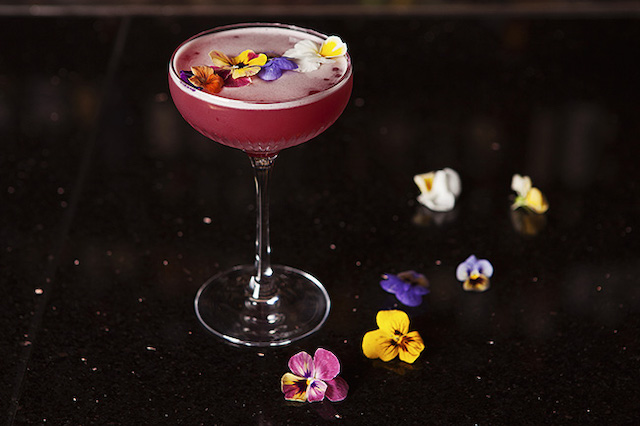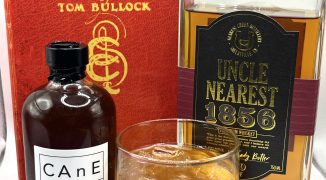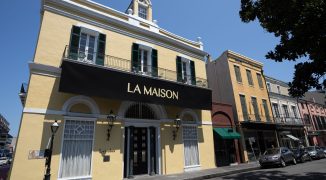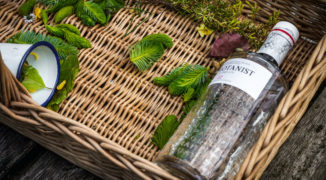Whether a rose petal floating in a glass of special occasion champagne, a sprig of lavender sitting (somewhat impractically) atop a signature cocktail or a lone violet bobbing prettily in a drink to signal that spring has, in fact, arrived, floral garnishes have the power to take drinks from everyday to event-worthy. But sitting pretty on the sidelines isn’t the only thing they can do. Dried or fresh floral elements, ranging from honest to goodness flowers to herbs and other foliage, can be made into syrups, sugars, salts, infusions, bitters and shrubs and other tinctures.
1. Just add vinegar
“I make a variety of shrubs and it’s always like, the vinegar is always paired specifically to the fruit or vegetable that I’m using, so, as an example I have a cocktail right now that has a strawberry basil balsamic reduction shrub,” says Jason Eisner, beverage director at Gracias Madre and Cafe Gratitude. “But then I’ve also, with things like flowers, used much, much lighter, more soft and gentle and sometimes even naturally effervescent vinegars like champagne vinegar,” he says. “So I’ve actually made a flower shrub before. It was heirloom peach and edible white flowers with champagne vinegar. And that was used, we did a sort of soft twist on a bellini and a French 75, kind of thing.”
2. Simplify with a syrup
At Kali, also in Los Angeles, Drew Langley and his team uses flowers for shrubs as well as syrups. They do a lavender syrup for a non-alcoholic lavender lemonade and feature geranium in their Gower Flower cocktail, which includes rose geranium leaves, a fortified white wine from Sonoma and locally foraged Spanish peppercorn. Their nasturtium syrup adds a peppery kick to drinks, too.
3. Let the liqueurs do the legwork
One of the easiest ways to incorporate floral elements as an ingredient, rather than simply as a garnish, is to use floral liqueurs made from roses, violets, elderflowers and others, which many bartenders already do with regularity. St. Germain, the very popular French elderflower liqueur, is made from fresh flowers — never dried — because fresh and dried flowers have different flavors. Elderflowers bloom for a very short season every year, meaning St. Germain (and many floral liqueurs) must act quickly to gather the flowers while they’re still at the height of freshness.
“So I like to say that St. Germain will celebrate the art of the aperitif, slowing down, appreciating life, sipping on a refreshing cocktail, but actually the production is a race against the clock for us,” said Camille Vidal, global brand ambassador for St. Germain.
“[I]f you taste St. Germain, on the nose it’s going to be quite floral, and then quite citrusy and then on the palate you would have grapefruit and then pear and then more stone fruit, like peach and apricot, and then more tropical fruit, like passionfruit and pineapple. So all those different fruity notes are coming from the flowers and the only reason why we have this versatility is because we use the fresh flowers,” Vidal said.
4. Brush up on your ancient apothecary techniques
St. Germain wrings all the flavor out of elderflowers using a process called dynamic maceration, which results in an elderflower infusion. Another technique used to extract flavor from flowers is enfleurage.
“Enfleurage, from the Grasse region of Southern France, is an ancient technique that’s been used for centuries before solvent extraction was used and is now a traditional activity passed on through generations. Stable and solid fats are layered in thick lines on panes of glass, while fresh flowers are layered on top; flowers become encased in the fats, as the next layer is placed on top, and so on. After several weeks, flowers are removed, the oil is gently melted and strained then either washed with alcohol or steam distilled to extract the essential oils. Most of the earlier techniques used to extract essential oils and preserve flowers are still used; however, most have technological updates to increase their quality and efficiency for a growing fragrance industry,” said Lauren Mote, co-proprietor of Bittered Sling, beverage consultant for the Four Seasons and Canadian ambassador for World Class.
5. Smoke ‘em, mist ‘em, foam ‘em
Presenting floral ingredients in new ways is another novel approach some barmen take. Smoking, misting and creating foams are only a few of the ways flowers are being transformed.
“One of my favorite ways to serve an Aviation cocktail, which has a little bit of violet liqueur, is I love to mist that liqueur inside the chilled cocktail glass before I pour the Aviation cocktail in it. The scent of violet is, it can be very overpowering, dominating, and it’s one of the reasons why people aren’t too fond of the Aviation cocktail, but when used in a delicate fashion, then it can be an incredible addition to a complexity of flavor profiles,” said David Wolowidnyk, bar manager at CinCin Ristorante in Vancouver and a hospitality specialist. “And so it has this evolution of flavor profiles that otherwise wouldn’t have happened if we had just put a couple of drops of that violet liqueur in the cocktail itself.”
Eisner created a new drink that he’s made vegan with the help of an aquafaba lime and fennel pollen foam and he does a smoked gin and tonic at Cafe Gratitude Newport.
“I’m using flowers in this homemade gin and homemade tonic cocktail in two separate ways. The first is, we go out to Malibu and we wild harvest chamomile, so we urban forage wild chamomile and then the tonic that I made for this cocktail is actually a wild chamomile tonic and so the actual tonic in this gin and tonic has an element of florality, which pairs really nicely and strangely softens all the botanical elements in the gin. And then, the second thing we do, is we actually smoke, so it’s served in a glass globe, like a little tiny glass atrium, and we smoke the inside of that globe with tea flowers. So we go out, and we purchase tea flowers and then we put [them] in a PolyScience Smoking Gun and we actually walk by the table as it’s delivered and we smoke the inside of the globe, so it’s really pretty, it’s visually pleasing, it gives off a really cool quality of aromatics that tea, that tannin that’s in the tea, actually plays very well in an aromatic way as well, like it dries out, you can kind of smell how it like literally dries out the inside of the cocktail, but also like, your skin, the elements of Earth around you—it’s really interesting,” Eisner said.
And finally, some parting words of wisdom
If you’re going to start integrating flowers on your bar menu, there are a few things to keep in mind.
“Treat flowers as you would any other fruit, herb, spice or ingredient. The first thing to do, is analyze the flavor and inspect the product — NEVER EVER use sprayed or florist-purchased flowers unless you are certain they’ve come from a fresh, non-pesticide sprayed source. Purchase your flowers from fresh produce suppliers, farmers and local produce markets, or better yet, your own garden. Ensure the flowers are edible, and do a page of research on their origin, medicinal qualities and flavor profile, to ensure they’re safe to use. Some easy examples: rose, jasmine, lavender, honey suckle, pansy, viola; other great examples: hibiscus, daisy, violet, orange blossom, marigold, elderflower, geranium, lilac — endless possibilities. Lastly, the technique will always change based on the proposed finished application. Whether white spirits or oak aged, it’s possible to use flowers in all circumstances. For example, sous-vide low temp cooked honey suckle with amontillado sherry and honey can create an interestingly developed and gently caramelized floral liqueur perfect for cognac or whisk(e)y. On the contrary, white spirits would benefit from an oleo saccharum made from hyssop and lavender flowers, bashed with a moral and pestle into fine white sugar and allowed to preserve for three days,” Mote suggested.
People are more interested in unique ingredients and fresh, seasonal finds than ever before. For Wolowidnyk, that’s part of what makes using botanical fun.
“I think that it’s one of the main reasons why we have people heading towards interesting cocktails rather than running away from them because they’re curious. They’ve had a taste and they want more.”





